Issue number 121
Newsletter Winter 2023
Winter 2023 Newsletter, edited by Cynthia Brown
Welcome to the latest edition of the LAHS Newsletter. Contributions to future editions of the Newsletter are as always welcome at any time. These can be emailed to the Newsletter editor, Cynthia Brown, at newsletter@lahs.org.uk.
LAHS NEWS
LECTURE PROGRAMME FOR 2023 - 24 SEASON
Unless otherwise notified, lectures will be held in the Victorian Art Gallery at Leicester Museum & Art Gallery, New Walk, and start at 7.30 pm. Please use the main entrance to the Museum on New Walk, and arrive in good time to avoid disruption once the lecture has started. Members will be notified nearer the time if pre-booking is necessary.
Suggestions for lectures for the 2024 - 25 season are also very welcome at this stage. Please email them to LAHS Hon Secretary Jim Butler at secretary@lahs.org.uk.
Thursday 25 January 2024
Peppermint Billy and the Tollgate Murders
Joanne Mungovin
Local author and historian
Thursday 8 February 2024
Members’ Evening
If you would like to present the results of your research to fellow members, please contact the Hon. Lecture Secretary by email at lectures@lahs.org.uk.
Thursday 14 March 2024
The Alan and Joan North Memorial Lecture - discovering Rutland Roman villa
Jim Irvine
Farmer and amateur historian
Thursday 21 March 2024
Taking Stock of the Pot: creating and recreating the Glenfield Iron Age cauldrons
John S. Thomas
University of Leicester Archaeological Services
Thursday 18 April 2024
Brewing History and Pubs in Leicester
Laura Hadland
Local historian
Thursday 2 May 2024
Excavations at St. Anne’s Charterhouse in Coventry
Andy McLeish
University of Leicester Archaeological Services
Thursday 23 May
Excavations of a Later Prehistoric Landscape and Iron Age Settlement at Broadnook Garden Village, Wanlip
James R. Harvey and Adam Clapton
University of Leicester Archaeological Services
NEW LAHS WEBSITE – HOW TO MAKE THE MOST OF THE NEW MEMBERS’ AREA
LAHS was delighted to announce the launch of our new website at www.lahs.org.uk in November 2023. Please do make use of the ‘Members only’ section of the website at Sign in - LAHS, which enables you to view all articles from the current and previous year’s issues of Transactions and the Leicestershire Historian by selecting ‘Publications’. Older volumes of Transactions are now accessible via the Archaeological Data Service (ADS), and previous issues of the Leicestershire Historian will also become available through ADS in the very near future. The ‘Members only’ area also allows you to manage different aspects of your LAHS membership once you are logged in:
Membership Fees: check your subscription is up to date, and find details of how to make a payment.
Contact Details: check and update the personal details that we hold for you.
Email and Password: make a change to these here.
Gift Aid: Make a new declaration here. Our income increases by about £5 per subscription if members Gift Aid their subscription.
Communication Preferences: Select how you would like to hear from us and access our publications. You can now choose either digital only via your account on the website, or by hard copy in the post.
Video Archive: LAHS members also have access to a new Video Archive on the website. This can be accessed at Video archive - LAHS where you will find the video of ‘Leicester Cathedral Revealed’ by Mathew Morris. More videos will be added in due course.
If you have not already logged in to the ‘Member’s only’ area, you just need click on the SIGN IN button at the top of the home page and follow a few simple steps. If you have any issues or feedback - or are able to offer support in developing the website further - please do not hesitate to contact membership@lahs.org.uk. You can also access the LAHS ‘X’ account (formerly Twitter) from the button at the foot of the website home page. This has now been updated to @LeicsArchHisSoc to replace the previous @LAHSoc account. LAHS also has Instagram (@leics_arch_hist_soc) and Facebook accounts. Follow these to keep an eye on our activities as well as items of wider interest.
IF YOU ARE NOT ALREADY A MEMBER OF LAHS - WHY NOT JOIN?
Membership of LAHS offers a wealth of benefits, including copies of our two annual publications, the Leicestershire Historian and the Transactions of the Society. Members can access our current publications in digital format, and previous publications are available through the Archaeological Data Service. Regular Newsletters and updates on the activities of LAHS are also circulated by email. Very importantly, membership offers a forum for those interested in researching and learning about different aspects of Leicestershire and Rutland's past. You will also be entitled to vote at our AGM and help shape the future of the Society. Free student membership is available, and carries the same benefits as Individual membership with the exception of copies of the Society's two annual publications and a vote at the AGM. You can join LAHS on our website at Membership application - LAHS by completing an online application, or printing off a paper copy to send to our Hon. LAHS Membership Secretary Gillian Rawlins, c/o LAHS, The Guildhall, Guildhall Lane, Leicester, LE1 5F. If you have any queries please do contact her at membership@lahs.org.uk. If you have received this Newsletter by post and do not have access to the Internet, please write to her instead at the same address. You will be very welcome!
LAHS DISSERTATION PRIZES 2024 – DEADLINE FOR SUBMISSIONS 31 DECEMBER!
LAHS awards four annual dissertation prizes for extended projects that focus on the Archaeology and/or History of Leicestershire and/or Rutland. There are two prizes for Archaeology, for the best Undergraduate (BA/BSc) and the best Post-Graduate (M-level) dissertations, and two prizes for History, one for Undergraduate and one for Postgraduate levels. The subject area includes comparative studies, where Leicestershire/Rutland is one of the main comparisons used. It also includes art and design histories, and museum and heritage studies, where the focus is on Leicestershire and/or Rutland.
The 2024 prize is for dissertations written during the 2022-23 academic year. Dissertations should not previously have been published or be in publication. Each prize winner will be awarded £250 and the opportunity to publish some of their work in the Leicestershire Historian. The abstract will be published on the LAHS website. There will also be an opportunity for the winners to present their work at the annual members’ evening. The winners will also be awarded LAHS membership for one year. Copies of the winning dissertations will be printed and lodged in the LAHS Library, in The Guildhall, Leicester.
The deadline for 2024 prizes is 31 December 2023. An application form, available on the LAHS website, should be submitted along with a copy of the dissertation. Electronic copies of each are required. Prizes will be awarded at the Alan and Joan North Memorial Lecture meeting in March. Enquiries should be directed to the convenor of the prize committee, Professor Elizabeth Tingle, at competitions@lahs.org.uk. Please feel free to circulate this information to your own networks, or to individuals who may be interested.
LAHS PUBLIC HERITAGE FUND
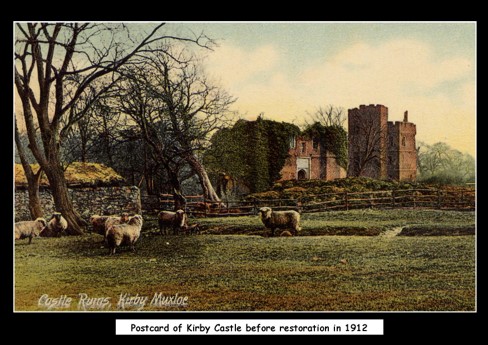
The LAHS Public Heritage Fund is pleased to announce a grant to the Kirby Muxloe History Group for the development of a new website. Kirby Muxloe has a significant archaeological and historical heritage, and has played a significant part not only in the history of Leicestershire but also that of the country itself. This project will endeavour to bring this history not just to the community but to a much wider public. It will produce an interesting and informative website to provide a valuable resource for the village, schools, genealogists, and researchers further afield. The current website has become obsolete, so a professional company will develop the new online resource. For details of how to apply for a PHF grant, see www.lahs.org.uk/grants/public-heritage-fund. The next funding round ends on 19 January 2024.
LEICESTERSHIRE HISTORIAN – A PREVIEW
LAHS members will soon be receiving their copies of the Leicestershire Historian – but if you would like a preview of its contents, go to Leicestershire Historian - LAHS.
AN APPEAL FOR HELP
A LAHS member has recently contacted us looking for someone to complete a project to understand the history of a site located next to the Church of St Mary Magdalen in Knighton, to help determine whether it may once have been the location of the medieval Manor. The study is likely to involve trips to the Record Office. Please do get in touch if you are interested to find out more by emailing membership@lahs.org.uk.
OTHER NEWS
‘SOUNDS FOR THE FUTURE’ – NEW ONLINE LEARNING RESOURCES
The East Midlands Oral History Archive (EMOHA) and Special Collections at the University of Leicester have recently completed the ‘Sounds for the Future’ project, funded by the National Lottery Heritage Fund to secure the future of the archive’s collections of EMOHA. These have now been preserved in a new digital preservation system, and the cataloguing brought up to date. ‘Sounds for the future’ has also produced new learning resources using oral histories as sources to explore personal stories and time periods. These are of particular relevance to the Key Stage 3 history curriculum in schools, but will be of interest to a much wider audience. One resource is based on the experiences of Dora Schutte, who grew up in Nazi Germany in the 1930s and moved to Leicester in the 1950s, while the other draws on interviews mainly recorded in the 1980s and 1990s with first and second generation migrants to the city. They can be accessed at Learning | East Midlands Oral History Archive | University of Leicester.
THE FIELD DETECTIVES – HISTORIC LANDSCAPE INVESTIGATIONS
Since 1999, The Field Detectives have been working alongside fellow heritage sector colleagues, landowners, farmers, history groups and friends on historic landscape investigations across Nottinghamshire, Leicestershire, and Rutland. Richard Pincott contributes this account of recent work in Leicestershire:
One of our avenues of investigation focuses on RAF Langar and the 207 Squadron from 1942-1943. Working with the Goadby Marwood History Group and our aviation historian colleagues, we helped to find the crash sites of two Avro Lancaster MK I aircraft. It was a beautiful collaboration of many that brought together families of those long-lost brave young airmen. Once forgotten, they were now remembered. In March 2021, we concluded our Goadby Hall Grounds historic landscape study, which brought together in one place a host of associated research documents and information that had previously proved difficult to access. The most amazing discovery of the investigation was being made aware that somewhere in a field there was an aircraft crash in 1946. The only thing anyone knew about the crash at the time was that it was a Canadian pilot, and that he died on the field. A mammoth family history research adventure opened the pages on a most remarkable family heralding from South Africa in the 1930s. This amazing story can be downloaded from our website, and it is the families’ wish that the book be made available to everyone for free.
At St Guthlac’s church in Stathern on 7 October 2023 we delivered a presentation to a full house on our findings from the initial phase of ‘The Search for Stathern Hall’. This was a re-examination of previous research and archaeological activities that took place from 1999 - 2005. A follow-up presentation is being planned for May 2024, which will include the opportunity for people to get involved with and help to inform and shape the Stathern Heritage Detectives development.

An additional landscape feature might be of interest to some of you. The line of the Grantham Canal runs through Nottinghamshire and Leicestershire, and along its route it has left a catalogue of fascinating clues on the landscape relating to the history of the canal and people living in the city of Nottingham in the form of artefacts emanating from the use of night soil. This is an avenue of investigation we are pursuing in collaboration with the National Poo Museum on the Isle of Wight (and yes, we didn’t know there was one until we delved deeper into the broader research of the study). Stories from the toilet can tell us more than we ever thought possible. It is a fascinating subject. Someone once asked me, after all those years out on the field, what was the greatest treasure that you ever found? The answer was easy: it was the story. If you have a landscape mystery you would like us to explore with you, or if you just want to learn more about us, please visit our website at www.the-field-detectives.com.
NEWARKE HOUSES MUSEUM - ‘OUT OF THE STORES – SHOES’ EXHIBITION
The autumn exhibition at Newarke Houses Museum in Leicester explores shoe fashions over the last 400 years through shoes and shoe related objects from the museum’s extensive collections. A variety of shoes will illustrate the many different reasons why we wear the shoes that we do, and how shoes can celebrate special events and major milestones in our lives. The exhibition also explores shoe superstitions, among them why people in the past deliberately hid shoes in buildings: was it for protection or good luck? Leicester’s shoemaking heritage is highlighted with shoes, catalogues, photographs and advertising from many local factories. Members of the public are also invited to share their own shoe stories and their memories of Leicester's shoemaking heritage by emailing museums@leicester.gov.uk. The exhibition runs until 14 January 2024. For further details, see Event Details – Leicester Museums.
JESSIE POPE – LEICESTER-BORN POET
An article by Margaret Brecknell on the poet Jessie Pope, who was born in Leicester in 1868, has recently been published in the Great Central Gazette. Entitled ‘The controversial legacy of Leicester-born poet Jessie Pope’, this focuses on what has been described as the ‘propaganda poetry’ that she wrote during the First World War for the Daily Mail and other popular publications. The article is available at The controversial legacy of Leicester-born poet Jessie Pope (greatcentralgazette.org).
GARENDON CARTULARY PURCHASED BY THE BRITISH LIBRARY
A 15th-century cartulary from Garendon Abbey has been purchased at auction by the British Library. The Abbey was founded for Cistercian monks in 1133 by Robert de Beaumont, and dissolved by the commissioners of Henry VIII in 1536. The cartulary was first described by John Nichols in The History of the County and Antiquities of Leicester (1804), when it was in the hands of the antiquary Craven Ord (d. 1832). It later passed into the collection of the bookseller William Foyle, and was auctioned as part of the library of his grandson, Christopher Foyle, who died in 2022. The cartulary has been exposed to damp over the years, and will now be assessed and treated by the British Library’s conservation team. After being digitised it will be made available in the Library's Manuscripts Reading Room at St Pancras. For further details, and images of the cartulary, see Medieval manuscripts blog.
LEICESTER CATHEDRAL – REOPENING

Leicester Cathedral has recently been gearing up for its grand reopening on Sunday 26 November. There has been a wealth of activity, with volunteers assisting with the cleaning of brasses and silver, final work being done on our new guide book, and our contractors, Messenger, pulling out all the stops for handover of the site back to the Cathedral. Three preview events took place in the week before the reopening, along with two volunteer re-induction sessions. Our visitor experience team has also been bolstered by the arrival of 13 new volunteers. We welcome the skill and breadth of life experience they will doubtless bring to the team.
So, what of our first impressions? Most striking is the sense of space and colour opening out before us. There is a freshness too about the place, with our stained glass in particular benefitting from the general tidying up of the masonry. The relocation of the font to the south aisle is a particular enhancement, resting as it does on a plinth carved from Kilkenny marble by the redoubtable sculptor James Elliott. A slight repositioning of three 14th century figures of ease, resting beneath a south wall shelf, is another pleasing aspect. Previously obscured and badly lit, they are doubtless a Cathedral treasure. And the Golden Book, a memorial to the 11,000 local men who fell during the Great War? Well, this now finds itself beneath and adjacent to Christopher Whall’s beautifully rendered windows to St Martin, the patron saint of soldiers and pacifists.
From the beautiful pendant lighting to the perfectly levelled and exquisite stone flooring and everything in between, this is a project perfectly realised to this point. There’s more work to be done, of course. Significantly, the reinforced concrete frame of the new Heritage Learning Centre is in place, and the two basement floors sitting below ground are now built. Truly, we can rejoice in what has been achieved and look forward with confidence to what lies ahead.
Rebecca Hale, Volunteer Manager, Leicester Cathedral
LEICESTERSHIRE COUNTY COUNCIL MUSEUMS – CHARNWOOD AXE ANALYSIS
Neolithic polished stone axes are some of the oldest and most tactile objects within our Archaeology collection. During the Neolithic period (c.4,000 – 2,200 BC) stone from outcrops across Britain was used to make this kind of axe. It is believed that stone from Charnwood Forest was utilised, and axes thought to be made from this Leicestershire stone are known as Group XX axes. But which outcrops exactly were used? Archaeologist Dr David Field, geologist Mik Markham and University of Leicester PhD researcher, Jonathon Graham are trying to pinpoint the axe quarries by analysing Charnwood rock outcrops and Group XX axes in museum collections around the country (for the Implement Petrology Group’s Charnwood Axe Head Project, Group XX).
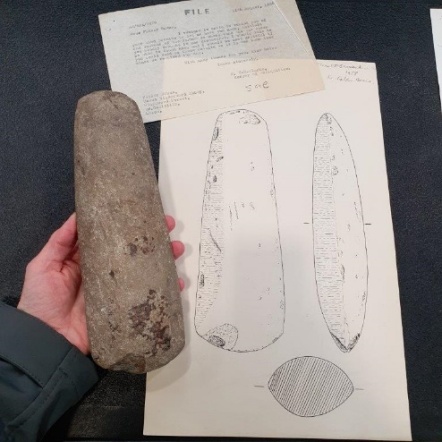
During a visit to one of our collections stores they analysed Neolithic polished stone axes from our collection using a portable XRF (X-Ray Fluorescence) machine. The hand-held machine emits a directed radiation beam that measures the chemical content of a rock that can then be compared with other rocks. This is a non-invasive technique that improves upon older techniques whereby a section needed to be removed from the artefact being analysed. The results of this work will update and enhance the Neolithic Stone Axe implement petrology record, which catalogues all the stone axe heads found within the British Isles. The results will be published in due course and we can’t wait to find out how far our ‘local axes’ travelled from their source! See www.leicestershirecollections.org.uk for more details.
Helen Sharp, Curator (Archaeology)
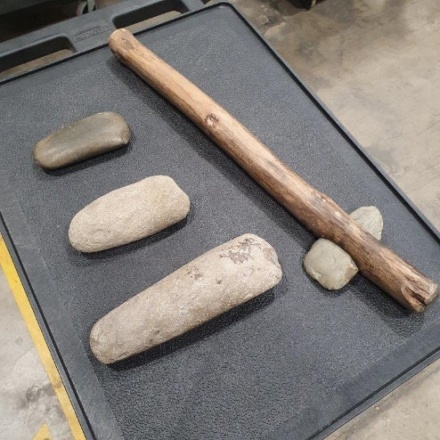
MARKET HARBOROUGH HISTORICAL SOCIETY – BOOK REPRINT
Due to popular demand Market Harborough Historical Society has decided to reprint A History of Market Harborough: from earliest times to the 18th century, Volume 1. It will be available in bookshops and on sale at the Society’s events, price £15, hardback. For further information, see home (marketharboroughhistoricalsociety.org).
DIGITISED RECORDS OF THE SCOTTISH WOMEN’S LAND ARMY AND TIMEBER CORPS
The National Records of Scotland (NRS) has announced the release of digitised records documenting the contributions of the Scottish Women’s Land Army and Timber Corps during World War II. These offer a comprehensive look into the lives of nearly 10,000 women who stepped into essential roles traditionally occupied by men from 1939 to 1950, and include 10,000 meticulously handwritten index cards featuring details such as names, ages, dates of service, and training insights.
The cards go beyond basic documentation, offering insights into the women’s experiences, aptitudes and work ethic, and noting awards for dedicated service. They cover women born up to 1922, but additional records will be added annually. To explore the records, go to the ScotlandsPeople website.
ARCHAEOLOGY
UNIVERSITY OF LEICESTER ARCHAEOLOGICAL SERVICES (ULAS)
Dr Gavin Speed informs us that ULAS have recently bid farewell to former Post-Excavation Manager Nick Cooper, and sends this update on recent ULAS activities.
Autumn has seen a return to a busy period for us, with some large excavations taking place across the region. Within Leicestershire, notably a large Roman ‘barn’ structure has been discovered at Quorn, whilst at Sileby a new excavation has recently got underway. At Quorn, excavation of a large area has recently been completed at Flesh Hovel Lane. The 2023 excavations were located immediately east of a small area excavated in autumn 2022 and to the west of cropmarks indicating a probable Bronze age barrow, excluded from the development area. Stripping and subsequent excavation revealed the continuation of an Iron Age enclosure containing scored ware, first seen in 2022. The bulk of the excavation focussed on a rectilinear enclosure in the south-east quadrant of the site. This appeared to be Roman in date, containing at least three phases of recutting tagged on to an earlier enclosure at its north-east side, which headed beyond the excavation area to the east. Sitting perpendicular within the enclosure, the excavation team began to tease out what eventually became a large post-built structure of Roman date, possibly an aisled barn. The structure eventually consisted of 16 large postholes, eight on each side measuring c.21m in length and c.8m in width with two likely associated gullies immediately north and south. The postholes were noted by their size and depths with the majority containing large granite packing stones and evidence of post pipes. The building appeared contemporary with the latest phase of recutting of the rectilinear enclosure surrounding it, bending in slightly to meet its ‘gable’ ends.
In September ULAS led a new student training excavation of a late Romano-British farmstead near to the village of Laughton in southern Leicestershire (image below) This was primarily for undergraduate students at School of Archaeology and Ancient History, University of Leicester, but also for members of local historical groups (Oadby & Wigston Fieldwork Group (OWFG) and Hallaton Fieldwalking Group). The excavation was targeted on geophysical anomalies (many interconnecting ditches and other features) to better understand the nature of the surviving archaeological evidence.
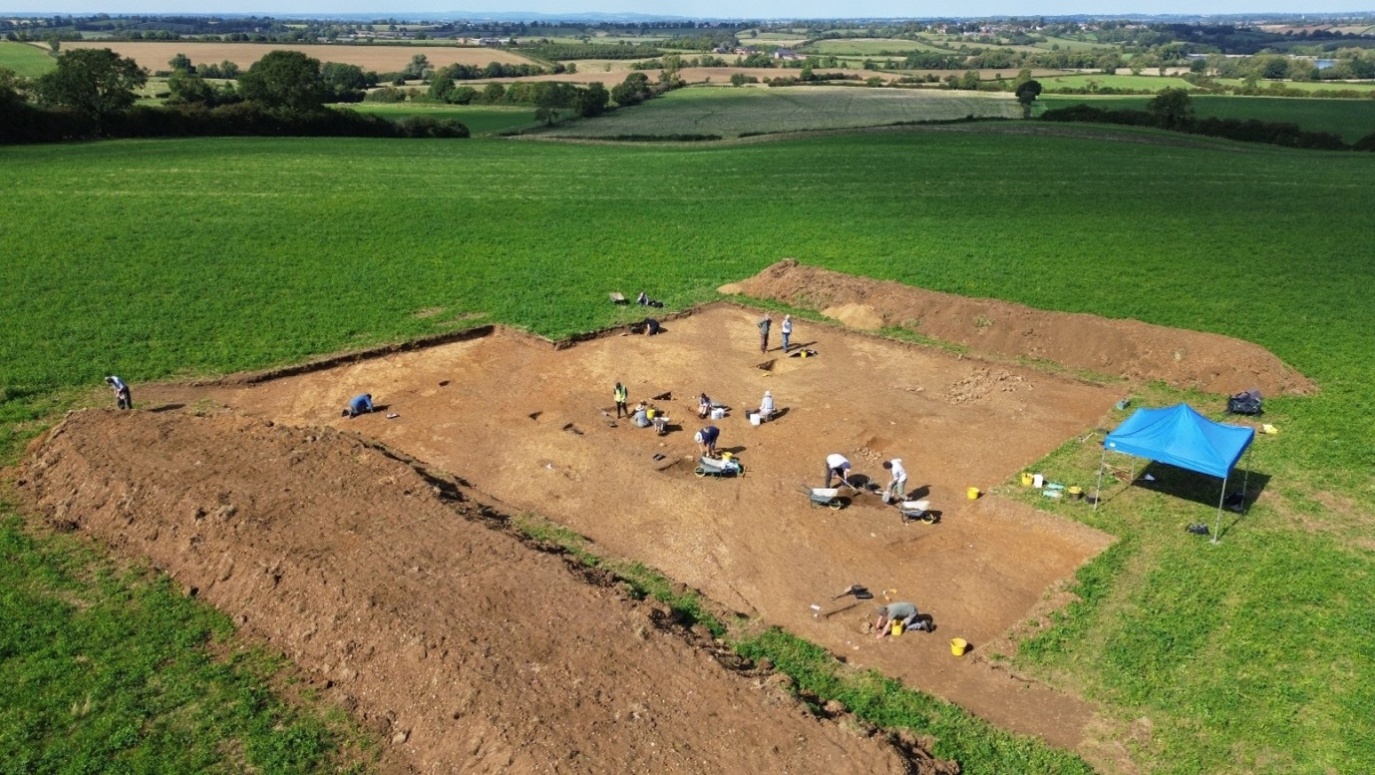
The excavation confirmed good survival of the Roman remains, with at least two phases of ditches found, parts of former livestock enclosures within a larger farmstead. Within these were cobbled surfaces, three corn driers, and refuse pits. Many of these archaeological features contained pottery sherds, animal bones, coins, and several other small objects. All in all, this was a very successful first venture into this site, and it is hoped to return to it in future to learn more about this newly discovered Roman site.
At Great Easton, a strip, map and sample excavation revealed scattered Roman 1st-2nd century AD activity in one area. Low-level late Anglo-Saxon/Saxo-Norman activity was followed by a major expansion of activity across the site from the 11th century, which ran into the 13th century. Parallel ditches extended northeast towards Caldecott Road from a substantial boundary ditch. The ditches were associated with a network of smaller gullies, likely defining small closes or animal pens, in addition to truncated pits and post holes. An unusually rich assemblage of fish bone recovered from two near-complete pottery vessels from one of the 13th century ditches may represent the remains of a fish stew. Activity ceased and the site was effectively abandoned in the 14th century.
FORTHCOMING EVENTS
LEICESTER CIVIC SOCIETY
Leicester 1923 – as the city emerges from a pandemic and a war
Saturday 16 December 2023, 10.30 am – 12 md, starting from Curve Theatre, LE1 1SB
A Christmas stroll through Leicester looking at how the city was 100 years ago – coming out of the First World War, a flu epidemic and gaslight to the age of the flapper, increasing mechanisation and the cinemas and dance halls of the time. It will take in aspects of life in Leicester in 1923: housing, industry, faith, entertainment, shopping, transport, education, politics, welfare, technology and social trends. The walk will be led by Jim McCallum; £5 for members, £6 non-members. To book, see Leicester 1923 – as the City emerges from a Pandemic and a War - Leicester Civic Society.
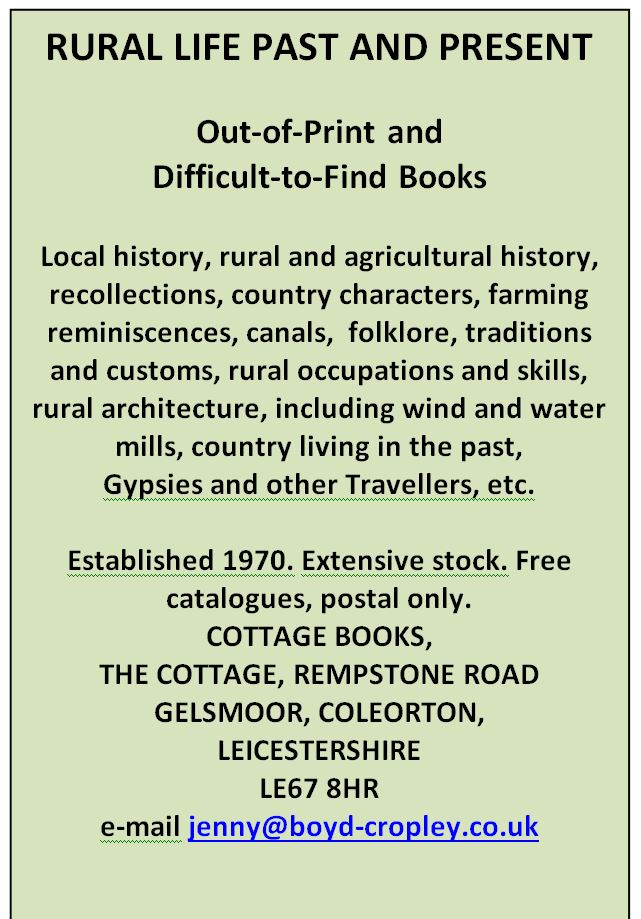
MARKET HARBOROUGH HISTORICAL SOCIETY
Wednesday 10 January 2024, 7.30 pm, Youth Wing, Market Harborough Methodist Church, Northampton Road, Market Harborough, LE16 9HE. Doors open 7 pm.
Eleanor of Castille
Dame Sara Cockerill KC
Eleanor of Castile (1241 - 1290) was Queen, constant companion and advisor to the Plantagenet Edward I. Her influence was covertly strong in politics and she was a notable landowner in her own right - building a vast property empire whose heart lay close to Market Harborough. Sara will give an account of her life and her links to the area. Please note the change from the usual venue, next to its previous venue in the Methodist Church Hall. All are welcome.
RECENT PUBLICATIONS
IMAGES FROM A DISAPPEARING WORLD: THE LEICESTER AND SWANNINGTON RAILWAY
Vic Millington
Leicestershire Industrial History Society, 2023, 130pp, illus, ISBN 9781999779375, £25
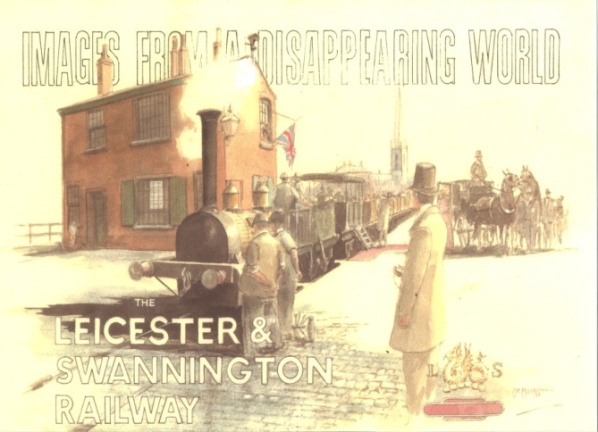
Vic Millington worked on the railways in Leicestershire and Cornwall for over 40 years, and used his time after retiring to paint pictures of locomotives. Over a four year period, Vic produced the 130 images of the Leicester and Swannington Railway reproduced in this unusual and very attractive addition to its history. Many are based on his collection of books, photos and newspaper cuttings, along with other ‘paper relics’ such as tickets and timetables, and text that places the paintings in their wider context. Vic never worked on the line, but there is an evocative painting of his first glimpse of it with his father in 1948 as an introduction to its history from the start of its construction in October 1830.
Every imaginable aspect is covered, including stations along the route, the freight carried by the railway, coal mines, bridges and quarries, the departure of the last shunting horse from West Bridge, and the last passenger train at Glenfield in September 1928. As Vic writes: ‘It is our duty to record some of those things from everyday life that once we took for granted, and will soon be lost forever’. The book does so in a unique and very attractive manner. It is available through Leicestershire Industrial History Society by contacting Chris Hossack, telephone 0116 241 5153 or email chris_hossack@yahoo.co.uk.
LOUGHBOROUGH PUBS
Lynne Dyer
Amberley Publishing, 2023, 96pp, illus, ISBN 9781398113435, £15.99
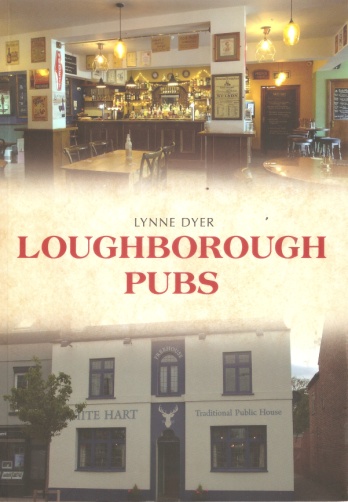
Lynne Dyer continues her series of Amberley publications with Loughborough Pubs, which promises ‘a fascinating journey through the town’s watering holes, many of which have retained features and traditions of previous ages’. Demand for drinking establishments and off-licences increased as the town expanded with industrialisation in the 19th century, and by 1889 over 260 places were licensed to sell beer. Among the ‘quirky tales and fascinating facts’ included in this comprehensively researched book are those of the Loughborough Arms in Baxter Gate, originally a coaching inn on the Earl of Moira’s land known as the Rose and Crown, which was also used as a venue for land and property auctions, inquests, and an annual celery show; The Windmill, Sparrow Hill, which identifies itself as ‘The oldest pub in Loughborough’; and The Priory on Nanpantan Road, with the appearance of a ‘fairy-tale French chateau’, but named after Ulverscroft Priory nearby. Entries are accompanied by at least one high quality colour photograph, and there is also a map showing the location of each pub.
LEICESTER TRAMWAYS
Colin Barker
Middleton Press, 2023, 96pp, illus, ISBN 9781910356838, £18. 95
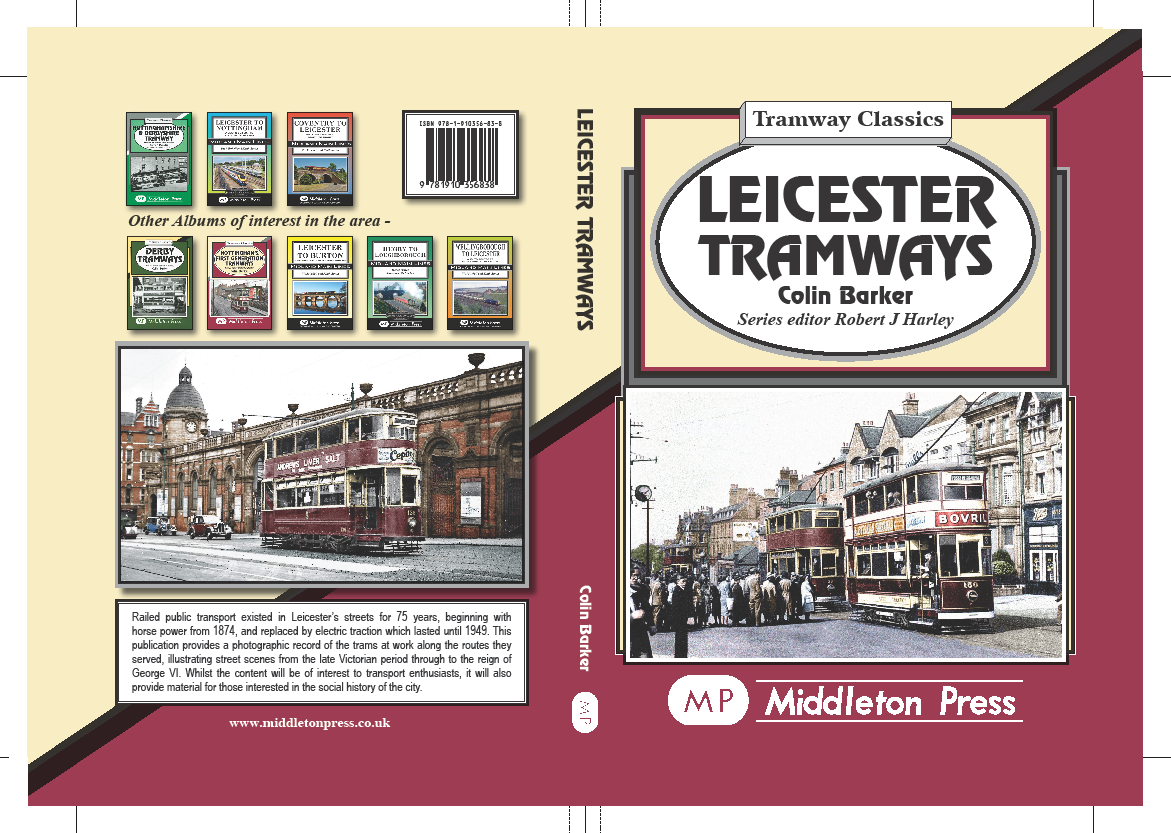
This book is not intended as a history of Leicester’s tramway systems, although it does provide a useful overview. It offers instead a ‘nostalgic journey’ along the streets served by the trams, with images of the vehicles themselves, starting with the horse buses and trams of the later 19th century. The majority of images are naturally of the electric trams that operated from 1904, and each is accompanied by a comprehensive caption giving information about routes, buildings in the background, and other relevant information. Car 86, for instance, pictured outside the then Freeman’s Arms pub on Welford Road (later the Physio and Firkin), was the first tram to be fully enclosed (in 1924), while the adverts carried by the trams are fascinating in themselves, ranging from ale, stout and gin to holidays in Brighton, and the benefits of Typhoo Tea for indigestion. Alongside the street scenes there are sections on decorated trams, depots, employees, and a Fleet List, and the long-running debate in the 1930s as to whether the trams should be replaced by trolleybuses or motor buses. All in all, those who have read earlier publications on Leicester’s trams will still find much to interest them in this new publication.
THE HINCKLEY HISTORIAN – MAGAZINE OF HINCKLEY AND DISTRICT MUSEUM,
NO 92, WINTER 2023
Various authors
Hinckley and District Museum, Winter 2023, 32pp
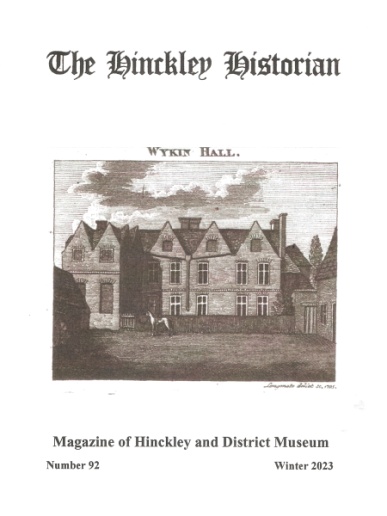
This edition of the Hinckley Historian begins with the article ‘Fred Warren (1909 – 1998): a clerk’s notes’, based on a file of his notes recently passed to its author Greg Drozdz for deposit in the Museum collection. Fred was once Deputy Clerk to Hinckley Urban District Council (HUDC), and the file consists of copies of letters between him and various correspondents on a range of local history and heritage issues. The main focus of the article is on the naming of streets in Burbage. Dave Knight contributes a detailed analysis of Hinckley through the eyes of the Georgian press. Although this consisted largely of advertisements, it also carried short notices of events, often far from the place of publication. Thus the Ipswich Journal of 7 September 1728 includes a description of ‘a very lamentable Fire in Hinckley in Leicestershire, which consumed almost sixty dwelling houses…’. There are many other examples demonstrating the richness of this resource. The magazine concludes with an item on ‘Joseph Aloysius and the Hanson Cab’ from The Illustrated Sporting and Dramatic News, 14 April 1894. It can be obtained from the Museum, www.hinckleydistrictmuseum.org.uk.
* Full reviews of the above publications will appear in the 2024 edition of the Leicestershire Historian.
A HISTORICAL FOOTNOTE
Leicester’s Town Waits were a regular feature of the Christmas season in the past. ‘Waits’ were originally watchmen or guards, but often assumed a musical function later, playing on civic occasions throughout the year, and heading processions. There are references to payments to them in the Borough records from the late 15th century. Following the reform of the Corporation in 1835 the Town Waits were among the offices abolished ‘for the sake of economy’. They were later reinstated, but by 1925 their appearances were restricted to the fortnight before Christmas rather than starting the ‘season’ in November. While many people enjoyed their festive perambulations, there were also frequent complaints in local newspapers about them disturbing the peace at night and generally being a ‘nuisance’ – such as this letter to the Leicester Daily Post on 11 November 1873.
THE TOWN WAITS.
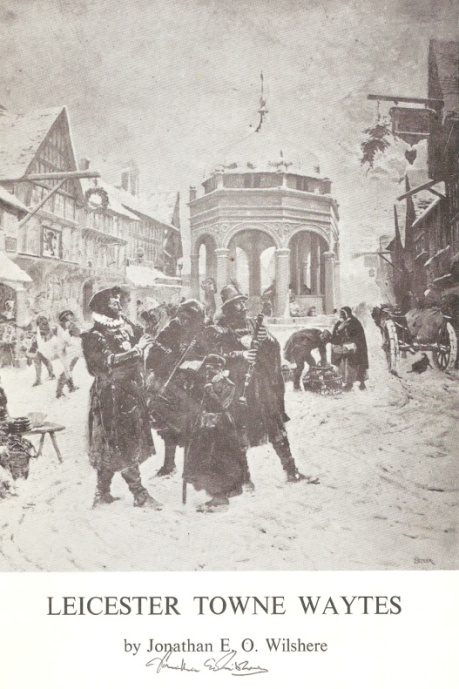
‘To the Editor of the Leicester Daily Post.
Sir,—May I enquire, through the medium of your paper, whether it is in the power of our worthy Chief Constable to prevent and stop the nocturnal nuisance caused by that very old-fashioned and useless band of musicians, “The Town Waits”? Children, especially infants and invalids, are frightened out of their slumbers by their playing, and this, frequently, after parents and nurses have been at considerable time and trouble to lull them to sleep.
‘The "Waits" may be classed as an unnecessary nuisance, for the players do not earn their living by their playing; and now that so many daily nuisances have been prohibited by the police, I think this nocturnal one might be dealt with. Nothing is more important to all than rest; and for a band of noisy musicians to be allowed to parade the streets at night, wakening people, especially children and other light sleepers, from their rest, is an unwarrantable nuisance. Trusting somebody may be inclined to take further notice of this matter who can deal with it.—l am, yours respectfully, RATEPAYER’.
In a similar vein, a correspondent to the same newspaper on 24 December 1888 described the Waits as: ‘relic of barbarism from the Middle Ages… Last night these wretched minstrels perambulated the district in which I reside for two or three hours… and it was no consolation to hear them play, after turning the corner into the next street, “Sleep gentle lady”…’.
The Waits ceased to exist in 1947, but the custom was revived for a time in 2002. There seems to be no record of what they actually played, but if you would like to know more about them, have a look at Jonathan Wilshere’s account at JEOW_TownWaytes.pdf (andrewwilshere.com), and ‘Leicester Waits’ at Leicester Waits – Guild of Town Pipers (townwaits.org.uk).
This newsletter is edited by Cynthia Brown and published by Leicestershire Archaeological and Historical Society. Further information about the Society, its publications and other activities can be found on its website at www.lahs.org.uk.
Background image: Leicester Towne Waytes
Leicester Towne Waytes



